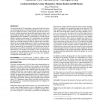Free Online Productivity Tools
i2Speak
i2Symbol
i2OCR
iTex2Img
iWeb2Print
iWeb2Shot
i2Type
iPdf2Split
iPdf2Merge
i2Bopomofo
i2Arabic
i2Style
i2Image
i2PDF
iLatex2Rtf
Sci2ools
CHI
1997
ACM
1997
ACM
The Design of a GUI Paradigm based on Tablets, Two-hands, and Transparency
An experimental GUI paradigm is presented which is based on the design goals of maximizing the amount of screen used for application data, reducing the amount that the UI diverts visual attentions from the application data, and increasing the quality of input. In pursuit of these goals, we integrated the non-standard UI technologies of multi-sensor tablets, toolglass, transparent UI components, and marking menus. We describe a working prototype of our new paradigm, the rationale behind it and our experiences introducing it into an existing application. Finally, we presents some of the lessons learned: prototypes are useful to break the barriers imposed by conventional GUI design and some of their ideas can still be retrofitted seamlessly into products. Furthermore, the added functionality is not measured only in terms of user performance, but also by the quality of interaction, which allows artists to create new graphic vocabularies and graphic styles.
Application Data | CHI 1997 | Human Computer Interaction | Non-standard Ui Technologies | Transparent Ui Components |
| Added | 06 Aug 2010 |
| Updated | 06 Aug 2010 |
| Type | Conference |
| Year | 1997 |
| Where | CHI |
| Authors | Gordon Kurtenbach, George W. Fitzmaurice, Thomas Baudel, William Buxton |
Comments (0)

